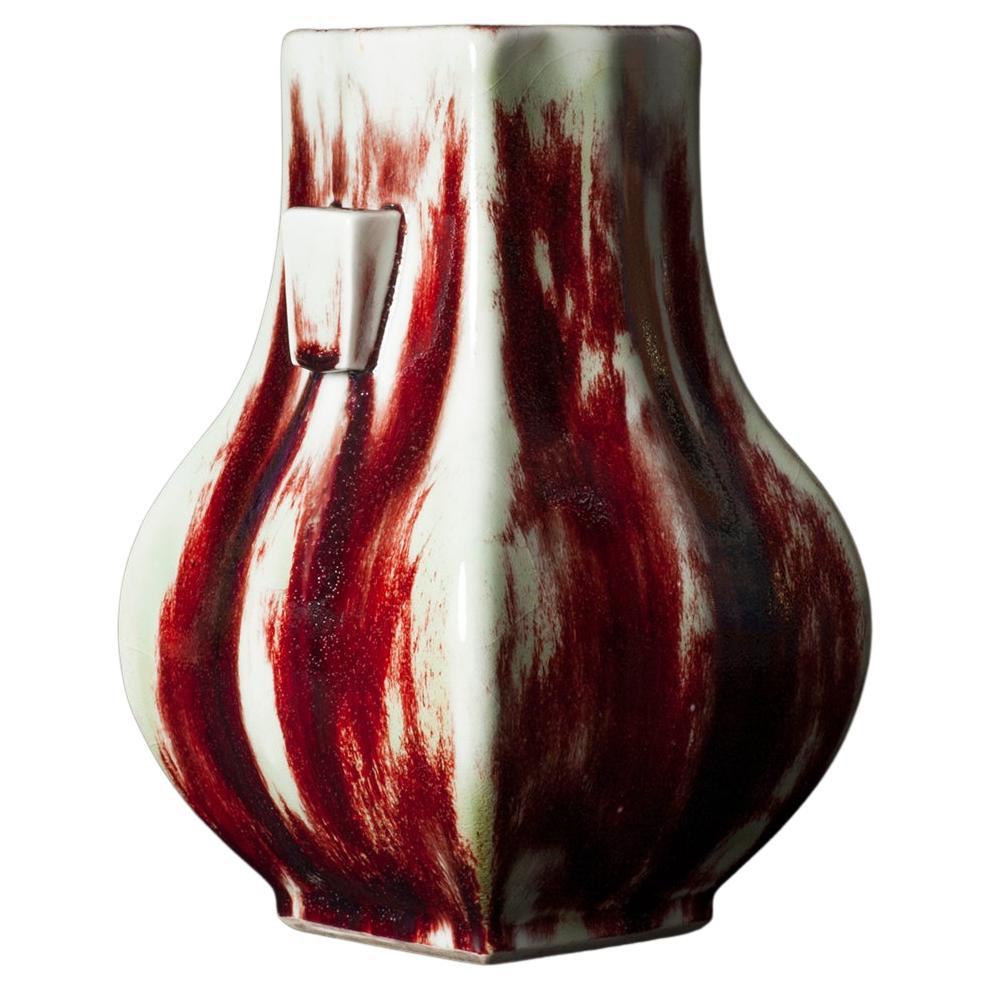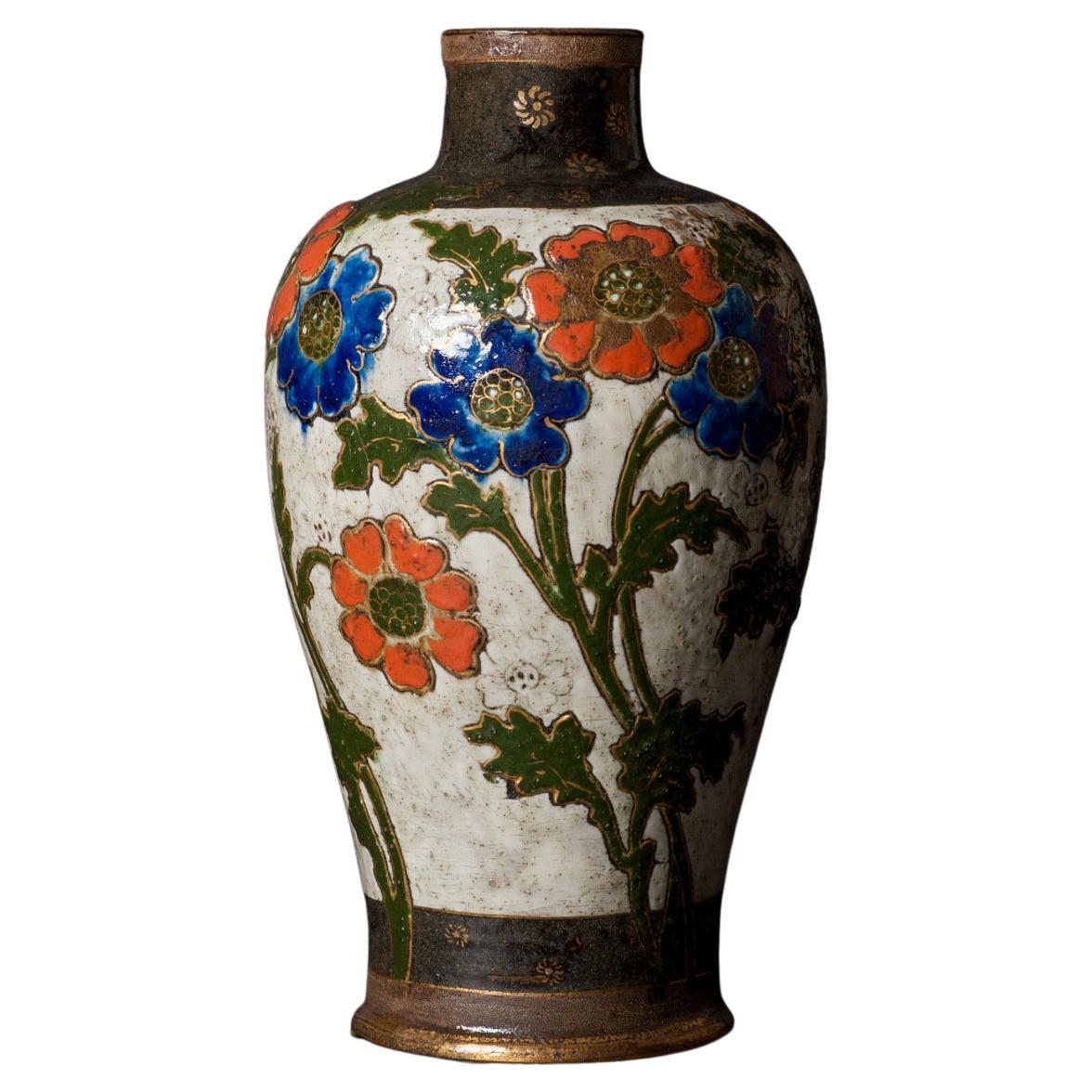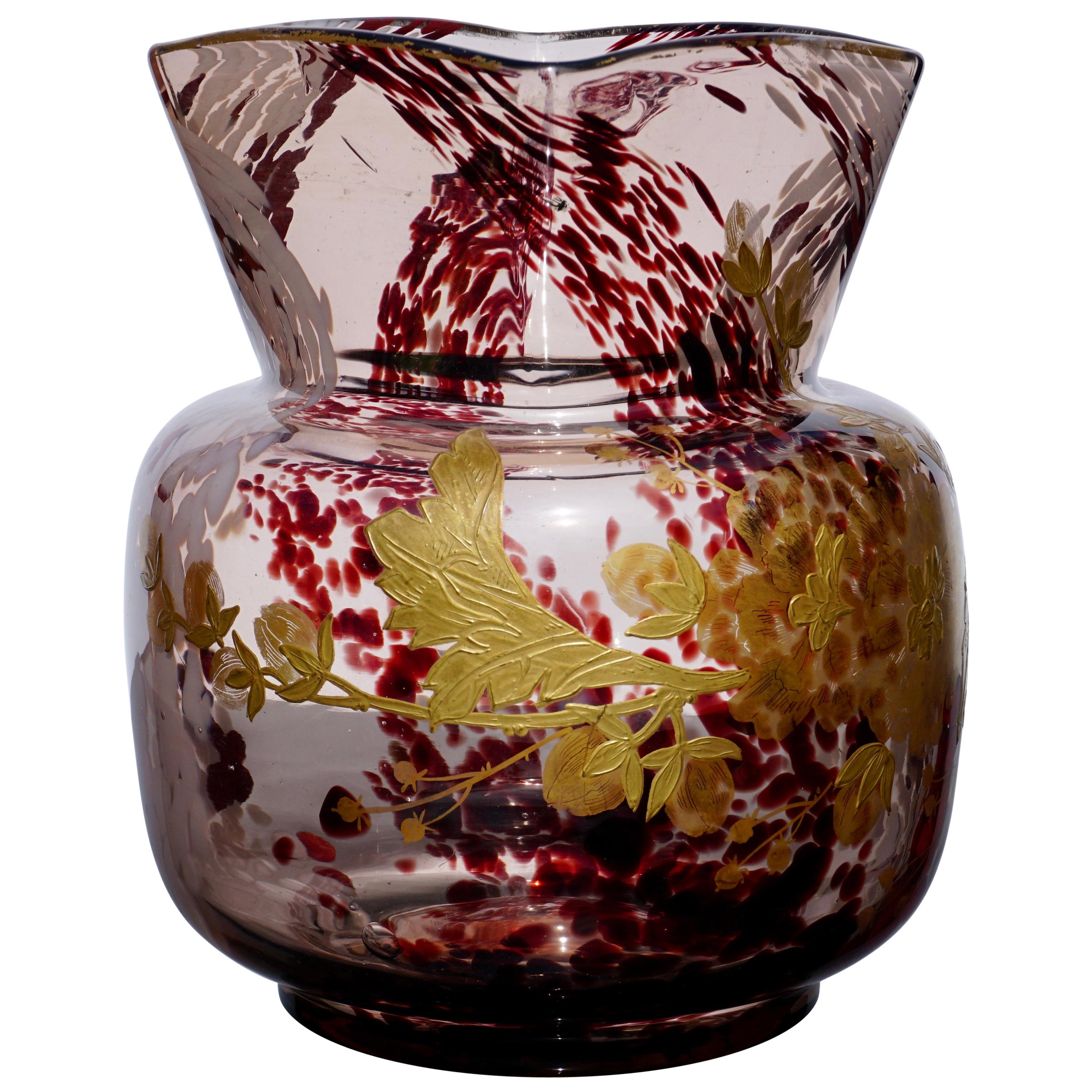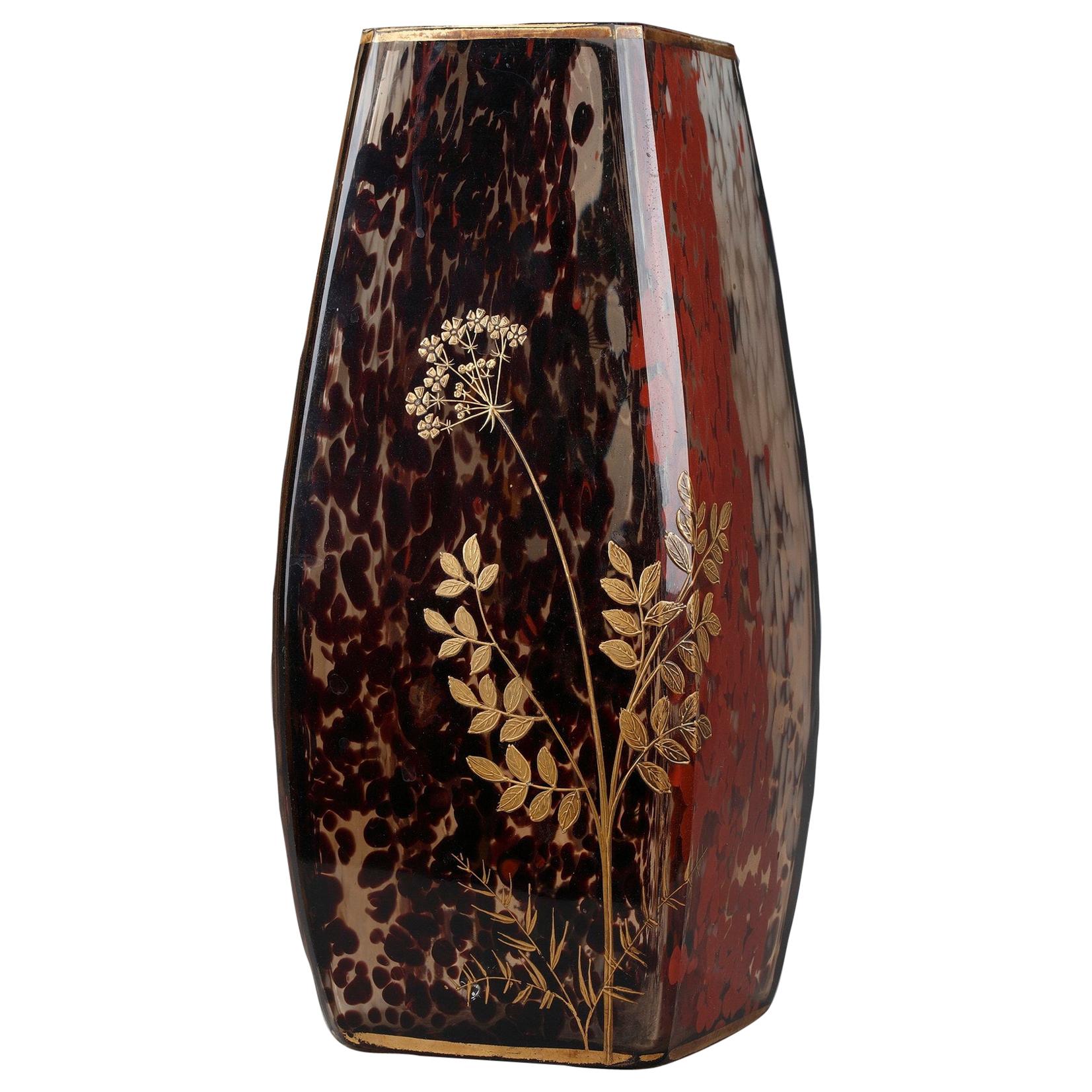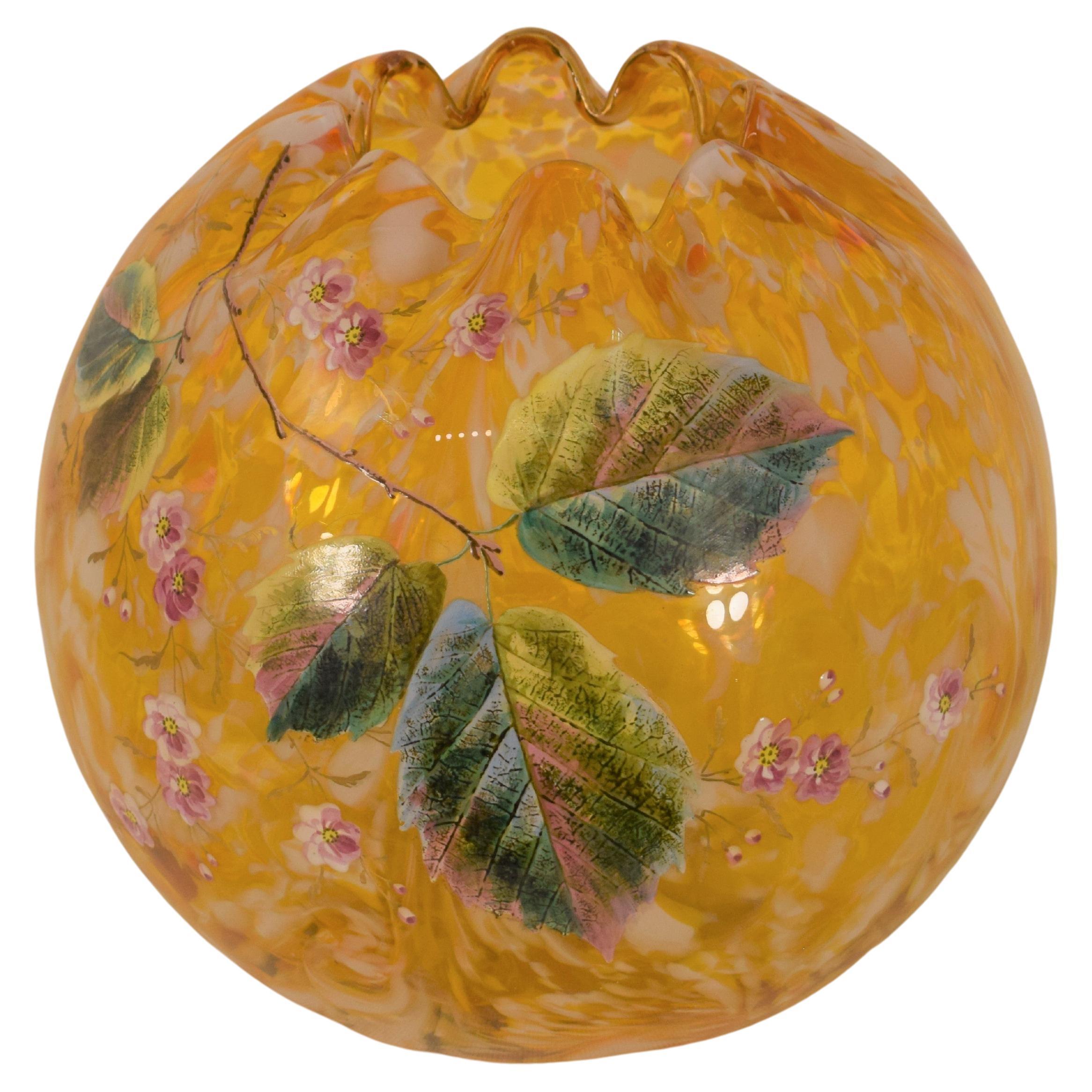Items Similar to Art Nouveau Porcelain Vase by Ernest Chaplet
Want more images or videos?
Request additional images or videos from the seller
1 of 7
Art Nouveau Porcelain Vase by Ernest Chaplet
About the Item
The Venus of Willendorf if she were a pot; this diminutive size is perfectly suited for holding in your hands. This pot is meant to be caressed. Its rather buxom top narrows at the waist, then swells out slightly at the hips to terminate at the foot of the pot in thick pools of glaze. Playfully, Chaplet allows a bit of the white unglazed ceramic to be exposed for a little titillation, like catching a glimpse of a petticoat. With fetish-like appeal, the thickly-applied matte glazes only add to the pot’s sensuality. Chaplet’s sang-de boeuf underglaze is tricked out in turquoise, white and ochre. Its textured abstract design takes on a similar captivatingly fetishistic quality. This is a one of a kind studio piece which was exhibited in Chaplet’s first retrospective exhibition held in Paris in 1910.
ERNEST CHAPLET (1835-1907) Not only was Chaplet France’s premier studio ceramist, the example he set of personally creating a ceramic object from the conceptual phase through modeling, firing and glazing - constantly reaching for new and innovative modes of expression and technique - elevated the notion of a ceramist from artisan to Artist. While Director of Production for Haviland & Co., Chaplet expanded their focus from porcelain into stoneware production and developed the barbotine method of painting earthenware with liquid clay as well as conducted extensive research in glaze techniques. He was awarded a gold medal in 1889 at Paris’ l’Exposition Universelle for his revolutionary sang de boeuf glaze. That same year, Chaplet opened his own atelier in Choisy-le-Roi where he continued to produce avant-garde stoneware and support younger talent.
- Creator:Ernest Chaplet (Artist)
- Dimensions:Height: 4.75 in (12.07 cm)Width: 4 in (10.16 cm)Depth: 4 in (10.16 cm)
- Style:Art Nouveau (Of the Period)
- Materials and Techniques:
- Place of Origin:
- Period:
- Date of Manufacture:ca 1890
- Condition:This exact vase was featured at the Chaplet retrospective exhibition in 1910 as well as photographed for the book "The Paris Salons: 1895-1914, vol IV, Ceramics and Glass", pg 83. Featured in "Art & Antiques" magazine: Summer 2017, pg 48.
- Seller Location:Chicago, US
- Reference Number:1stDibs: LU7300234637092
About the Seller
5.0
Gold Seller
These expertly vetted sellers are highly rated and consistently exceed customer expectations.
1stDibs seller since 2022
7 sales on 1stDibs
Typical response time: <1 hour
- ShippingRetrieving quote...Ships From: Chicago, US
- Return PolicyA return for this item may be initiated within 7 days of delivery.
More From This SellerView All
- Art Nouveau Blood Red Hu Stoneware Vase by Ernest ChapletBy Ernest ChapletLocated in Chicago, USComing from an artist who guarded his notebooks like trade secrets and purportedly destroyed them before his death in 1907, owning a vase from Chaplet’s experimental period is like p...Category
Antique 1890s French Art Nouveau Vases
MaterialsEnamel
- Art Nouveau Poppy Stoneware Vase by Ernest Chaplet and Edouard DammouseBy Ernest Chaplet, Edouard DammouseLocated in Chicago, USPoppies, golden-accented in analagous colors of blue and orange, creep up their leafy green stalks which sag from the heavy weight of the flowers. Like tired heavy-lidded eyes, the poppies symbolize hypnos’ sleep-inducing effects. Dammouse’s somnific symbolism evokes an other-worldly dream-like state and acts as a vehicle to tap into the imagination. Much more than a pretty face, or a pretty vase, this is a sublime piece of art, and Dammouse makes clear the influence of Braquemond and others by employing this Symbolist style. Beaudelaire’s credo that “Beauty must contain the absolute and the particular, the eternal and the transitory” aptly applies. Created while both Chaplet and Edouard Dammouse were employed by Haviland & Co. at its Paris location, this vase is a prime example of Chaplet’s early creative output of matte brown stoneware. Both artists demonstrate a strong link and affinity for Japonisme in the vase’s traditional form and in the painterly approach Dammouse brings to the enamel glaze. His treatment of enhancing the floral decoration with gold detailing calls to mind Kintsugi aesthetic principles. Affixed to the vase’s underside is its original label indicating it was sold at the chic A la Paix, a Parisian gallery located on the prestigious Avenue de l’Opera which opened in 1891, specializing in glass and ceramic objects of art. Ernest Chaplet (1835-1907) Not only was Chaplet France’s premier studio ceramist, the example he set of personally creating a ceramic object from the conceptual phase through modeling, firing and glazing - constantly reaching for new and innovative modes of expression and technique - elevated the notion of a ceramist from artisan to Artist. While Director of Production for Haviland & Co., Chaplet expanded their focus from porcelain into stoneware production and developed the barbotine method of painting earthenware with liquid clay as well as conducted extensive research in glaze techniques. He was awarded a Gold Medal in 1889 at Paris’ l’Exposition Universelle for his revolutionary sang de boeuf glaze. That same year, Chaplet opened his own atelier in Choisy-le-Roi where he continued to produce avant-garde stoneware and support younger talent. Edouard Dammouse (1850-1903) Trained as a painter, Paris born Edouard Dammouse studied under Felix Bracquemond, Ernest Chaplet’s predecessor at Haviland & Co.‘s Auteuil studio. Edouard followed his brother, Albert, and Chaplet to Haviland’s Paris...Category
Antique 1890s French Art Nouveau Vases
MaterialsEnamel
- Porcelain Art Nouveau Serpent Vase by Vilmos Zsolnay for ZsolnayBy ZsolnayLocated in Chicago, USZsolnay introduced its patented shiny metallic glaze, known as eosin, in 1893. The small family ceramics workshop begun in Pecs, Hungary by Miklos Zsolnay in 1853 had evolved into a ...Category
Antique Early 1900s Hungarian Art Nouveau Vases
MaterialsPorcelain
- Art Nouveau Porcelain Vase by Taxile Doat for Manufacture Nationale de SèvresBy Manufacture Nationale de Sèvres, Taxile DoatLocated in Chicago, USThe Manufacture Nationale de Sèvres, established in 1756, had fallen on hard times by the late 19th century, with critics accusing the factory of a lack of creativity and imagination...Category
Antique Early 1900s French Art Nouveau Vases
MaterialsPorcelain
- Art Nouveau Primordeal Vase by Raoul LachenalBy Raoul LachenalLocated in Chicago, USThe son of Edmond Lachenal, Raoul Lachenal worked in his father's studio until 1911, when he established a new workshop at Boulogne-sur-Seine. While some of Raoul Lachenal's Art Nouv...Category
Antique 1890s French Art Nouveau Vases
MaterialsStoneware
- Bronze Art Nouveau Scarab Vase by ChristofleBy ChristofleLocated in Chicago, USStamped 2299888 on bottom.Category
Vintage 1920s French Art Nouveau Vases
MaterialsBronze
You May Also Like
- Ernest Baptiste Leveille Art Nouveau Gilt Floral VaseBy Ernest Baptiste LeveilleLocated in Dallas, TXThese vase are hidden gems in the art glass world as they are never signed. Made by Earnst Leveille in collaboration with Eugene Rouseau in Paris, circa 1900; this vase in glass blow...Category
Antique Early 1900s French Art Nouveau Vases
MaterialsArt Glass
- Gold Porcelain Art Nouveau VaseLocated in Zephyr Cove, NVArt Nouveau style vase in gold porcelain with flowing swirled shape wrapping around to bulb base and up to flared top. Circa 1910Category
Antique Early 19th Century Art Nouveau Vases
MaterialsPorcelain
- Art Nouveau Speckled Glass Vase Attributed to Ernest LéveilléLocated in Paris, FRLate 19th century Art Nouveau cylindrical vase. The brown and red speckles create a dynamic pattern that is complemented by the gold umbelliferous plants. Attributed to Ernest Léveillé (1841-1913). Circa :1900 Dimension: W: 5.3 in, D: 5.3in, H: 11.8in. Dimension: L: 13.5cm, P: 13.5cm, H: 30cm. Ernest-Baptiste Léveillé (1841-1913), also known as Ernest Léveillé, was a porcelain and crystal manufacturer, active in the second half of the 19th century and the beginning of the 20th century. He is best known for his porcelain, but he also made Japanese vases, bamboo vases, ovoid and cylindrical vases decorated with plants... Founder of the Léveillé house in 1869 at 74 boulevard Haussmann in Paris, Léveillé acquired in 1885 the house E. Rousseau, a porcelain and crystal manufacturer, and operated the business from 1886 to 1890 under the name Maison Rousseau et Léveillé réunies. Léveillé created the models and had them executed and engraved. His cracked and engraved vases earned him a gold medal. When Eugène...Category
Antique Late 19th Century French Art Nouveau Vases
MaterialsGlass
- Ernest Baptiste Leveille, Vase Art Nouveau, France, 1910sBy Ernest Baptiste LeveilleLocated in Palermo, PAErnest baptiste leveille, vase art nouveau, France, 1910s. Dimensions: H= 21 cm; D= 21 cm.Category
Vintage 1910s French Mid-Century Modern Vases
MaterialsGlass
- Handpainted Vase Art Nouveau Porcelain Masterpiece by Fraureuth Art DepartmentBy Porzellanfabrik FraureuthLocated in Bad Säckingen, DEThis excuitie antique Art Nouveau porcelain masterpiece vase is a true marvel of craftsmanship. It features an exceptionally intricate hand-painted digitalis pattern, showcasing the ...Category
Early 20th Century German Art Nouveau Vases
MaterialsPorcelain
- French Art Nouveau Korschann Purple Porcelain VaseBy Charles KorschannLocated in New York, NYFrench Art Nouveau purple porcelain vase with female nude figure and bronze dore floral top and bottom (Korschann)Category
Antique Late 19th Century French Art Nouveau Vases
MaterialsBronze
Recently Viewed
View AllMore Ways To Browse
Hartwig Heyne
Holmegaard Atlantis
Jacques Blin Light
Kähler On Sale
Martin Potsch
Mcm Earthenware Vase
Moorcroft Hibiscus
Naaman Israel
Nittsjo Pottery Sweden
Reinhold Hanke
Robert Kuo Persimmon
Roseville Imperial
Royal Bonn On Sale
Soliflore Gio Ponti
Sottsass Euphrates
Sottsass Tigris Vase
Sottsass Tigris
Tanba Vase
